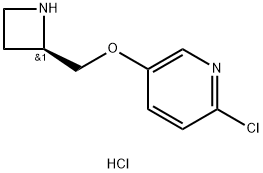209326-19-2
 209326-19-2 結構式
209326-19-2 結構式
常見問題列表
Ki: 37 pM (nAChR)
Tebanicline is a novel, potent cholinergic nAChR ligand with analgesic properties that shows preferential selectivity for neuronal nAChRs. It inhibits the binding of cytisine to α4β2 neuronal nAChRs with a K i of 37 pM. Functionally, tebanicline is an agonist. At the transfected human α4β2 neuronal nAChR in K177 cells, with increased 86 Rb + efflux as a measure of cation efflux, ABT-594 has an EC 50 value of 140 nM with an intrinsic activitycompared with (?)-nicotine of 130%; at the nAChR subtype expressed in IMR-32 cells, an EC 50 of 340 nM; at the F11 dorsal root ganglion cell line, an EC 50 of 1220 nM; and via direct measurement of ion currents, an EC 50 value of 56,000 nM at the human α7 homo-oligimeric nAChR produced in oocytes
Tebanicline is a potent antinociceptive agent with full efficacy in models of acute and persistent pain and that these effects are mediated predominately by an action at central neuronal nAChRs. Tebanicline produces significant antinociceptive effects in mice against both acute noxious thermal stimulation. ABT-594 is orally active, but 10-fold less potent by this route than after i.p. administration. The antinociceptive effect of ABT-594 is prevented, but not reversed, by the noncompetitive neuronal nicotinic acetylcholine receptor antagonist. Tebanicline has antinociceptive effects in rat models of acute thermal, persistent chemical, and neuropathic pain. Direct injection of tebanicline into the nucleus raphe magnus (NRM) is antinociceptive in a thermal threshold test and destruction of serotonergic neurons in the NRM attenuates the effect of systemic tebanicline.